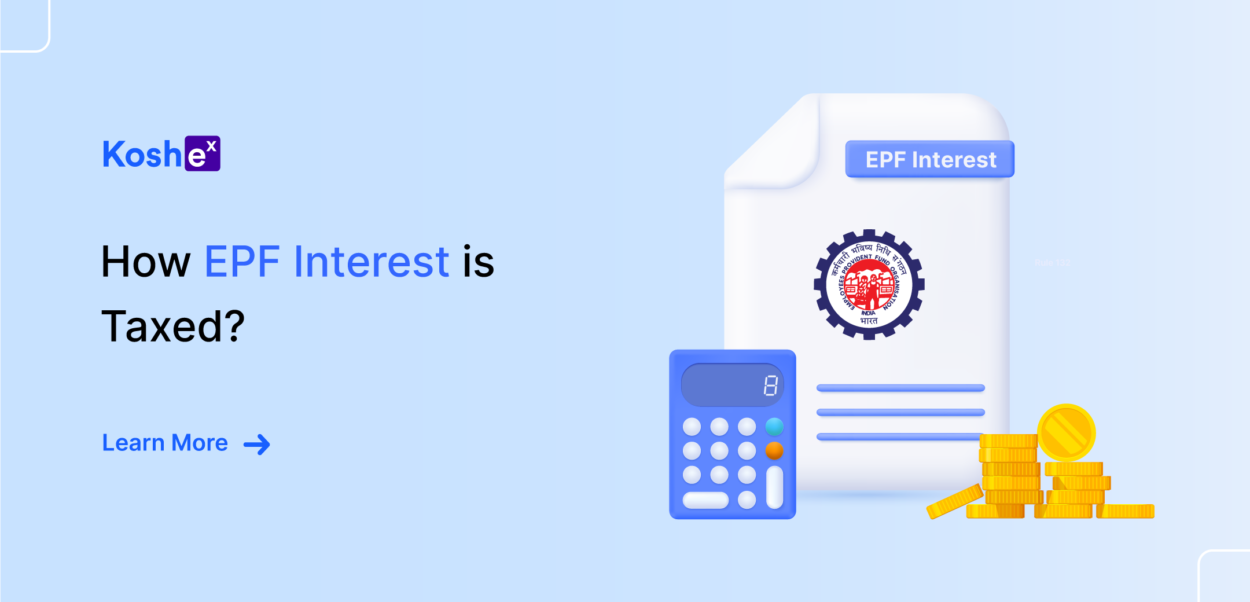Introduction
Employee Provident Fund (EPF) is a great tool for employees to inculcate savings and investments. Further, the tax benefits associated with EPF make it a further lucrative option for employees.
However, income tax law underwent certain changes whereby the interest earned from EPF was bought under the income tax net. Earlier, such interest was entirely exempt from tax.
However, after the amendments bought in the Budget 2021 by the Central Board of Direct Taxes, which became applicable from 1st April 2021, the interest on EPF is now partially exempt.
But how EPF interest is taxed in India is interesting. Let’s find out! Also, explore how Koshex presents one of the best investment alternatives, i.e., mutual funds with over 5000+ funds.
What is Employee Provident Fund?
Employee Provident Fund (EPF) is a beneficial scheme for employees of any organization and is managed by the Employee Provident Fund Organisation (EPFO). Any establishment that has 20 or more employees shall register under this scheme.
Further, establishments with employees below 20 can also register for this scheme voluntarily. Under the EPF scheme, the employees contribute a specific amount from their salary to the scheme. The same amount of contribution is made by the employers as well.
The employees should contribute Rs. 1800 or 12% of the basic salary and dearness allowance (DA), whichever is lower. The employer’s contribution should match the same.
The employees can also go for voluntary provident fund contributions, extending the above contribution to 100% of the employee’s basic salary. However, the employer is not liable to contribute more than 12% of the basic salary in addition to the dearness allowance of the employee.
How EPF Interest is Taxed in India?
As per the new income tax law provisions, the employee provident’s interest shall become taxable if it crosses a certain threshold limit. As per Section 10(11) of the Income Tax Act, 1961, the payment from a provident fund is exempted from tax.
However, suppose the contributions made by the employee exceed Rs. 2.50 lakhs in a financial year. In that case, the interest credited on such provident funds shall be taxable in the hands of the employees.
Further, if the employer is not contributing to such provident fund, the limit shall become Rs. 5 lakhs instead of Rs. 2.50 lakhs.
It should be noted that Rs. 2.50 lakhs and Rs. 5 lakhs are the contribution amount, not the interest amount. Secondly, the interest accrued on contributions above Rs. 2.50 lakhs or Rs. 5 lakhs shall only be taxable.
How Will It Work?
The provident fund trust will have to maintain two PF accounts. This includes:
- One account for contributions below the threshold limit. The interest credited to this account won’t attract tax liability.
- Second account for contributions exceeding the threshold limit. The interest credited to this account will be taxable in the hands of the recipient.
Further, the interest earned on EPF contributions till 31st March 2021 will remain non-taxable and be a part of a non-taxable account.
The interest getting accrued on the taxable account will be taxed every year. The previous year’s contribution will be carried forward to the subsequent years, and the interest accruing on the total taxable contributions will be taxed each year.
TDS Implications on EPF
Apart from income tax, the interest on EPF also attracts TDS provisions. Section 194A of the Income Tax Act of 1961 places responsibility on the payer of the income to deduct TDS on such income.
Here, the payer of the income shall be the provident fund trust that pays interest to the investors. The rate of TDS shall be 10%.
However, if the PF account is not linked with the PAN card, then the rate of TDS shall become 20%. But here’s a sigh of relief. The TDS shall be deducted only if the interest amount exceeds Rs. 5000.
The TDS rate is a bit higher for Non-Resident Indians. In their case, the TDS shall be deducted at 30% per Section 195 of the Income Tax Act.
But, if beneficial (lower) tax rates are prescribed under the Double Taxation Avoidance Agreement (DTAA), then such beneficial rates shall apply while taxing the income of the NRI from the provident fund.
Tax Payable on EPF Income
While we have discussed the tax rates and exemption on the employee provident fund interest, what will be the applicable tax rate on such income? Well, the tax rate applicable on the EPF interest will depend upon the tax rate applicable to us.
If we fall under the 20% tax slab, our interest income from EPF shall also be taxable at 20%.
Practical Example of EPF Taxability
Let’s understand EPF taxability through a practical example:
Suppose an employee is earning a salary of Rs. 70,000 per month. He contributes 12% of his basic salary + DA to the EPF.
Thus, his monthly contribution will be Rs. 8400 (Rs. 70,000 12%). A similar contribution is being done by the employer. Thus, the annual contribution towards EPF by both the employee and the employer will be Rs 2,01,600 (Rs. 8400 12 months * 2). As the contribution is below Rs. 2.50 lakhs in a financial year, thus it will not be taxable.
However, suppose the employee decides to make a voluntary contribution of Rs. 1 lakh over and above the contributions already made.
Thus, the total contributions now will be Rs. 3,01,600 (Rs. 2,01,600 + Rs. 1,00,000). Because the contributions have exceeded the limit of the Income Tax Act of Rs. 2.50 lakhs, the interest would become taxable.
The portion of contributions on which the interest will be taxed is Rs. 51,600 (Rs. 3,01,600 – Rs. 2,50,000 lakhs). This will form part of the taxable income and be taxed at the tax rate applicable to the employee.
Other Tax Provisions Governing EPF
Let’s look at other income tax provisions that govern the employee provident fund:
- Employee’s contribution to the EPF is eligible for deduction under Section 80C of the Income Tax Act, 1961. The maximum amount of deduction that can be claimed in a financial year is up to Rs. 1.50 lakhs.
- Employer’s contribution to the provident fund is exempt up to 12% of the employee’s salary.
- The interest of up to 9.5% of the provident fund is exempt from tax. Any interest above 9.50% shall be taxable.
In a Nutshell
Following were the detailed provisions governing the taxation of interest and contributions in employee provident funds in India. EPF is one of the few schemes that offer good returns with minimal risk. The interest rate on EPF is 8.10% per annum.
Considering that the risk is minimum, only a few schemes can provide such good returns. However, if we want a higher return and have a moderate risk appetite, we can go for mutual fund investment.
Koshex is an ideal investment platform that allows investors to invest in mutual funds, smart deposits, fixed deposits, and digital gold. With 5000+ funds, we can make our desired investment choice per our investment goal and risk appetite.
Further, ELSS funds are also eligible for tax benefits, just like EPF. It’s time we start growing our wealth with Koshex.
Frequently Asked Questions
Q: What is the lock-in period for EPF?
A: The EPF scheme continues till the retirement or resignation of the employee.
Q: Can we withdraw prematurely from the EPF scheme?
A: The lock-in period for withdrawal is five years. If we withdraw after five years of continuous service, there will be no tax consequences. However, if we withdraw before the completion of 5 years, the EPF withdrawal shall become taxable. However, no tax consequences shall follow if the withdrawal is less than Rs. 50,000.









Leave a Comment